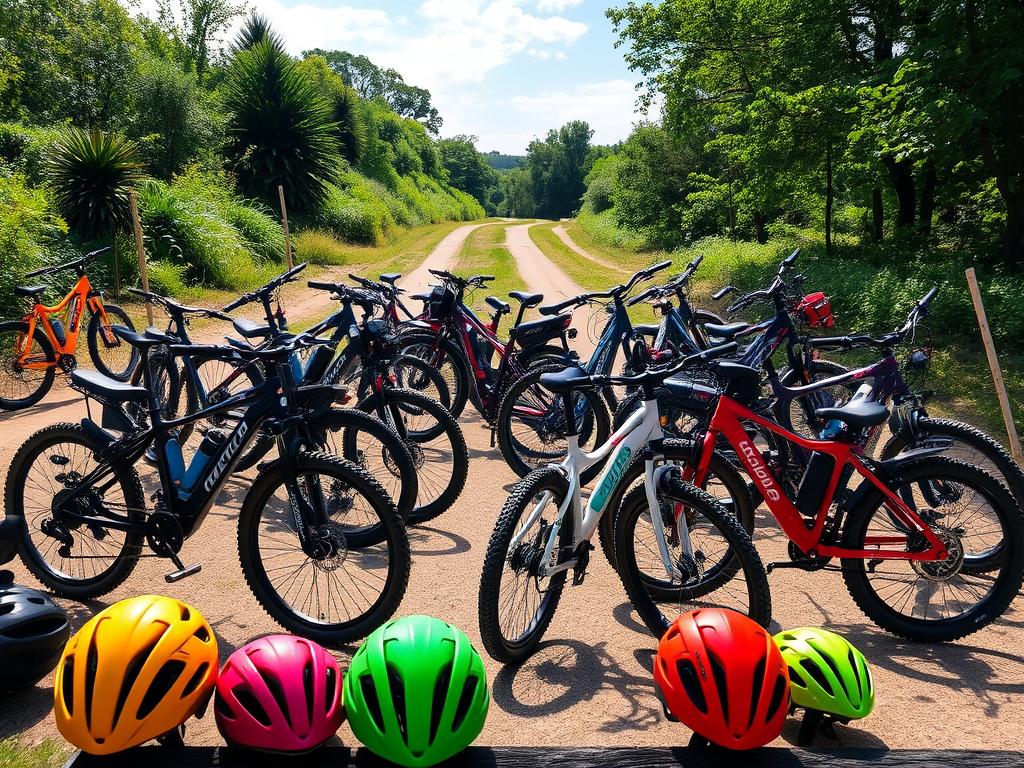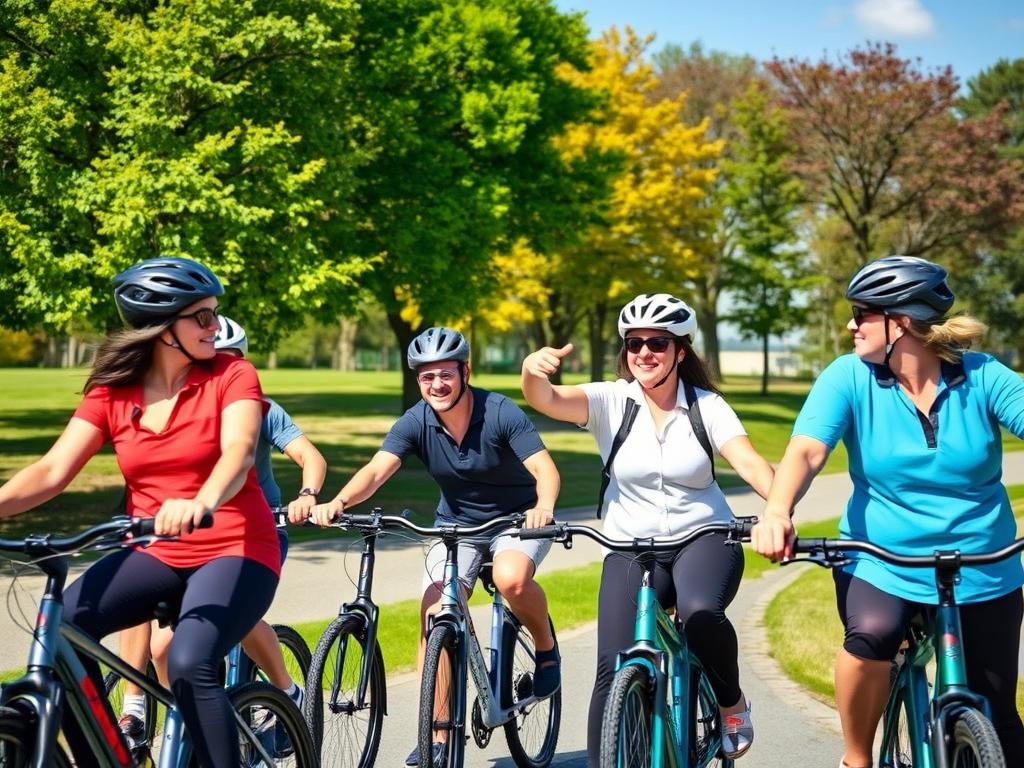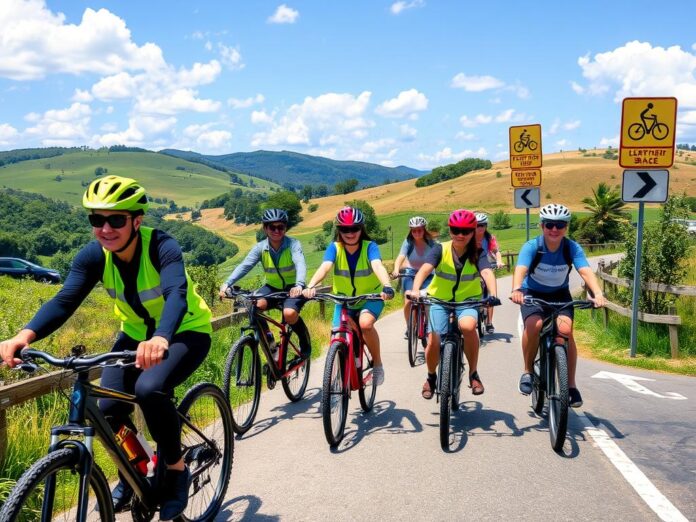Electric-assisted bicycles (e-bikes) are getting more popular in the United States. It’s important to stay safe when riding in groups. Knowing how to handle e-bikes, local laws, and group dynamics is key. This ensures everyone has a good time and stays safe.
E-bikes in the USA are divided into three types based on speed and pedal help. Knowing these types helps you understand where you can ride and what safety gear you need. It’s also important to check the e-bike laws in your area before you start.
When riding with others, safety comes first. Always wear a helmet, use hand signals, and stay alert. Also, make sure your e-bike is in top shape, with working lights and brakes.
Key Takeaways
- Learn about the three-class e-bike system and local laws for safe riding.
- Wear a helmet and use hand signals to communicate with the group.
- Regularly check your e-bike, including lights, brakes, and other safety features.
- Understand how e-bikes handle differently, like being heavier and needing different pedal speed.
- Match your riding style to the group’s pace and terrain for a better experience.
Understanding the Basics of E-Biking
E-bikes, or electric bicycles, are changing how we travel and enjoy nature. They have an electric motor that helps you pedal, making hills and long rides easier. As e-biking grows in the USA, knowing the basics is key.
What is E-Biking?
E-biking means riding a bike with an electric motor that helps your pedaling. There are different types of e-bikes, each with its own speed and power level. Some e-bikes help you pedal up to 20 mph, while others can go up to 28 mph.
Benefits of E-Biking
E-bikes have many advantages. They make commuting easier, let you travel farther, and are good for the environment. Most e-bikes use lithium-ion batteries, which can last 3 to 5 years. This means you can ride up to 44 miles on a single charge.
Popular E-Biking Destinations in the USA
The USA has many great places for e-biking, from city streets to trails. E-bikes let you explore more areas and enjoy different terrains. Whether you’re riding in the city or outdoors, there’s a lot to discover.

Learning about e-biking is important for safe riding. Knowing the different types and benefits helps you enjoy your rides. By exploring the USA e-bike destinations, you can have a fun and rewarding e-biking experience.
Preparing for Your Group E-Biking Adventure
Getting ready for a group e-biking trip is key to having fun and staying safe. Think about what kind of e-bike you need. Consider your riding style, the routes you’ll take, and the terrain. Choose an e-bike that offers the right mix of power, range, and comfort for your group.
Choosing the Right E-Bike
Picking the right e-bike is vital for a great group ride. Look at the e-bike’s class. Class one e-bikes go up to 20 mph and don’t have a throttle. Class two and three e-bikes are faster and have throttles, but might not be allowed on some trails. Brands like Bosch are favorites among e-bikers.
Essential Gear and Accessories
Along with your e-bike, you’ll need the right gear and accessories. Make sure you have a helmet that fits well, clothes that reflect light, and bike lights. Don’t forget water, snacks, and a repair kit for any surprises on your trip.
Checking Your E-Bike Before Riding
Before you ride, check your e-bike carefully. Look at the battery charge, tire pressure, brakes, and motor. Know how to use the throttle and brakes to stay safe and in control.
By preparing your e-bike and gear well, you’re set for a great group e-biking adventure. Teach everyone in your group about e-bike basics and safety. This way, everyone can enjoy a safe and fun ride together.

Planning Your Route Safely
Planning a group e-biking trip needs careful route planning for safety and fun. Look for bike-friendly trails that match your group’s skill level. Many places in the USA have special e-bike routes and paths, safer than busy streets.
Researching Bike-Friendly Trails
Use the League of American Bicyclists database to find trails. Check out Bikemap and Strava for user-made maps. Talk to local e-bike fans and cycling clubs for the best bike-friendly trails USA tips.
Understanding Local Traffic Laws
Learn the e-bike traffic laws in your area before you go. Rules on speed, lanes, and more are key for safety. Check with local authorities or e-bike shops for the latest e-bike regulations.
Using Navigation Apps for E-Biking
Use apps like Bikemap and Strava for route planning. They offer directions, obstacle alerts, and rest stop suggestions. These tools help keep your group on course and safe.
Good route planning is key for a fun and safe group e-biking trip. By researching trails, knowing traffic laws, and using apps, you’re set for a great adventure.
Group Ride Etiquette and Communication
Good communication is key for safe group e-biking. Use clear e-bike hand signals for turns, stops, and hazards. Choose a lead and sweep rider to keep everyone together.
Stay in a single-file line when riding with cars. Say “on your left” when passing others. Keep the pace steady and stop often to regroup. Make sure everyone is okay with the speed and terrain.
Establishing Hand Signals
- Make a set of hand signals for the group.
- Turn, stop, and hazard signals should be clear.
- Practice these signals before the ride to get everyone ready.
Setting Up Ride Leadership Roles
- Choose a lead rider to pace and guide the route.
- Have a sweep rider to check on the group and keep everyone together.
- Set up how the lead, sweep, and others will communicate.
Keeping Everyone Included and Safe
Keep the pace steady and stop often for the group to catch up. Know everyone’s skill level and comfort. Change the route or pace if needed, so everyone stays safe and happy.

“Group riding is all about communication, organization, and looking out for one another. By establishing clear protocols and leadership roles, we can ensure everyone has a safe and enjoyable experience.”
Safety Gear You Should Never Skip
When you go on group e-biking trips in the USA, wearing the right safety gear is key. The eBike market grew by over 23% in 2020. With 48 states now defining eBikes, safety is more crucial than ever.
Importance of Helmets
A DOT-approved helmet is the most important safety item for e-bikers. In 25 states and Washington D.C., wearing a helmet is required for eBike riders and passengers. It’s vital to wear one, no matter your age. If your helmet gets damaged or you crash, it’s time for a new one.
Visibility Gear and Lights
Being seen is crucial, especially when it’s dark. Make sure your e-bike has front white lights, rear red lights, and reflectors. Wearing bright clothes and reflective gear, like vests and tape, also helps you stand out.
Maintaining Your E-Bike
Keeping your e-bike in good shape is essential for your safety. Check the tires, brakes, gears, and steering often. Carry a repair kit with a multi-tool, bike pump, tire levers, spare tube, and patch kit for any issues that might pop up.
Using essential safety gear like helmets, visibility equipment, and keeping your e-bike in check can greatly lower accident and mechanical failure risks. This way, you can enjoy your group e-biking trips in the USA more safely.
Navigating Different Terrain Types
When you start your group e-biking trip, it’s key to adjust how you ride for different terrains. Whether you’re on smooth roads or rough trails, knowing the challenges of each helps keep you safe and happy.
Riding on Pavement vs. Trails
On paved roads, keep a steady pace and watch out for cars, people, and other bikes. Use your brakes and turn smoothly because the surface is even. But on trails, get ready for bumpy paths, obstacles, and changing grip. Shift your weight, use the right gears, and be quick to react to path changes.
Handling Weather Conditions
Riding an e-bike in various weather needs you to change your riding. Slow down and keep more distance in the rain to avoid slipping. Steer clear of deep water and lean into the wind to stay stable.
Tips for Group Riding in Hilly Areas
- Use your gears wisely to keep a steady pace up hills.
- Work together with your group to handle tough hills, letting beginners set the pace.
- Keep pedaling steadily to save energy and avoid getting tired on long climbs.
- Go down hills carefully, using brakes and shifting your weight to control your bike.
By improving your e-bike terrain navigation, weather riding tips, and group hill climbing skills, you’ll be ready for any landscape and weather you face on your group e-biking trips.
“The beauty of e-biking is that it lets riders of all levels explore and conquer tough terrain. With the right skills and prep, you can face any challenge confidently.”
Staying Aware of Your Surroundings
Being constantly aware of your surroundings is key for safe group e-biking. As an e-bike rider, watch out for other cyclists, pedestrians, and vehicles. This is especially important at intersections and on shared paths. Spotting hazards like road debris or potholes helps you and your group stay safe.
Watching for Other Cyclists and Pedestrians
E-bikes can go almost as fast as 30 mph. So, you must be very careful when sharing the road or path with others. Keep a safe distance and be ready to slow down or dodge if needed. Remember, e-bikes take longer to stop than regular bikes, especially at high speeds.
Recognizing Potential Hazards
The terrain and environment can have many hazards. Look out for potholes, cracks, and sudden changes in elevation. Be ready to react fast to avoid these dangers. Tell your group about any hazards you see to keep everyone safe.
Maintaining Situational Awareness
Don’t get distracted by your phone while riding. It can make you less aware of your surroundings. Stay alert, keep your eyes on the road, and be ready for anything. Always think about a quick escape route in case you need to dodge something.
Keeping an eye out for e-bike hazards, group riding safety, and staying alert is crucial for a safe group e-biking trip. By being vigilant and proactive, you can make sure everyone has a great time.
“Safety should always be the top priority when group e-biking. Staying aware of your surroundings and being prepared for any situation can make all the difference.”
Emergency Preparedness for Group Rides
Going on group e-bike rides means being ready for surprises. Having the right safety steps can keep your rides safe and fun.
Creating a First Aid Kit
A good first aid kit is essential for group e-bike rides. Include bandages, antiseptic wipes, gauze pads, and adhesive tape. Don’t forget medications and items for cycling injuries, like cold packs and emergency blankets.
Planning for Mechanical Issues
Even well-maintained e-bikes can have mechanical problems. Carry a toolkit with tire levers, a bike multi-tool, spare tubes, and a portable air pump. Also, bring an extra battery or charger in case of a power outage.
Establishing Emergency Communication Protocols
Clear communication is key in emergencies. Choose a meeting spot and share emergency contact info. Pick someone with first aid and bike repair skills to help if needed.
Planning for the unexpected makes your group e-bike rides safe and fun. Being ready for anything is the secret to a great group adventure.
Encouraging Responsible Riding Practices
As an e-bike enthusiast, it’s key to promote safe riding in your group. This keeps you safe and helps the e-biking community look good. It also keeps the trails and roads you love in great shape.
Following Traffic Rules and Signals
Always treat your e-bike like a car and follow traffic rules. Stick to speed limits, stop at red lights, and use turn signals. This makes you safer and helps everyone get along better on the road.
Educating Group Members on Safe Riding
Teach your group about safe riding, like braking and signaling right. Remind them to watch out for others and ride safely, especially in tough spots. Leading by example and sharing your knowledge makes e-biking safer and more fun for everyone.
Promoting Respect for the Environment and Wildlife
Responsible e-bike riders respect nature and wildlife. Stay on trails, throw away trash properly, and watch your noise level, especially in quiet places. By being a good example, you help protect the beautiful places we love to ride.






